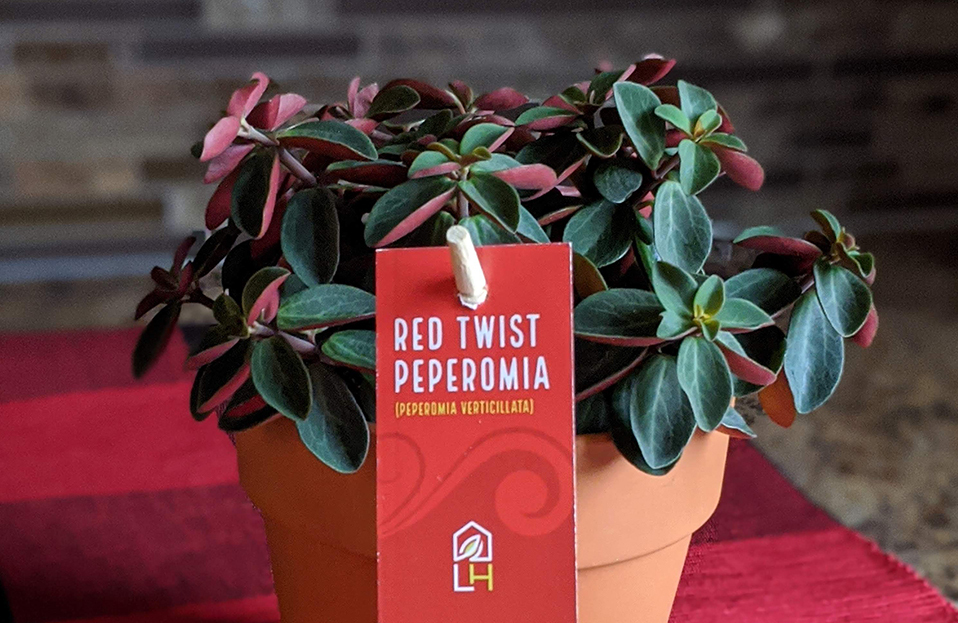

The Red Twist Peperomia, also known as "Red log", is a recent hybrid variant of Peperomia verticillata that was initially identified in 2014.
This hybrid stands out from other varieties due to its leaves, which are dark green on top and red underneath, as well as its vertical growth pattern and robust stems.
The “twist” in its name comes from the pattern of its leaves, which form a helix or whorl pattern while twisting down the stem.
Red twist is known for being a fast grower that is relatively hardy and easy to maintain.
At Living House we grow our Red Twist sustainably in our greenhouse from cuttings, but originally these plants are native to the rainforests of Bolivia.
Did you know? Over 1,000 known species of plants are in the peperomia genus! Most are known for having thick, fleshy leaves; however, they can vary wildly in colour and appearance.
Read on for more detailed care information!
Peperomia Verticillata plants prefers bright, indirect light. Position your plant close to a window where it can receive diffused sunlight during the day. Prevent direct sunlight exposure as it can cause the leaves to burn.
Let the top inch of soil become dry before each watering, then saturate it completely until you see water seeping out from the pot's base. Ensure that the pot has drainage holes to prevent waterlogging, as Peperomias are susceptible to root rot. If watering into a outer pot without drainage holes, be sure to check your plant after a few minutes, and discard any excess water sitting at the bottom.
Use a well-draining potting mix that retains some moisture but doesn't become waterlogged. A mix of peat moss, perlite, and coarse sand works well for Peperomia Verticillata. Repot your plant every couple of years to refresh the soil and provide it with fresh nutrients.
Throughout the growth period in spring and summer, nourish your Peperomia Verticillata using a balanced, water-soluble fertilizer. It should be diluted to 50% potency and applied every four to six weeks. Decrease fertilization during autumn and winter when the plant's development slows down. Be sure to follow the direction on the bottle for accurate dosing.
Peperomia Verticillata thrives in average room temperatures ranging from 65°F to 75°F (18°C to 24°C). This plant thrives in medium to high humidity conditions, so think about positioning a humidifier close by or frequently spraying the leaves to boost humidity. Keep the plant away from cold breezes or abrupt changes in temperature.
Peperomia Verticillata can be propagated easily through stem cuttings. Get a clean and sterile pair of scissors or razor blade and cut a healthy stem with several leaves attached to it. Put it in a container filled with water or a pot with damp soil. Keep the cutting in a warm, bright location and wait for roots to develop before transplanting it into its own pot.
Peperomia Verticillata, though generally resilient to pests and diseases, may sometimes face problems such as mealybugs, spider mites, or fungal diseases. Keep an eye out for any signs of pests or disease, and treat them promptly with insecticidal soap or fungicides if necessary.
Yes, Peperomia Verticillata is pet safe.
These plants are fast growers and will require regular pruning to maintain a compact, bushy appearance; otherwise, they will get quite “leggy.” Using a sharp, sterile knife, scissors or pruning snips, trim the top leaves above the node.
You may want to rotate your Red Twist weekly or whenever you water it to keep a balanced appearance because the stems will bend towards the light.
Overwatering is the #1 peperomia killer. Like other peperomias, the Red Twist likes to hold moisture in its leaves, which makes it semi-drought tolerant. If the plant is overwatered it can rupture the cell walls of the leaves or cause root rot. A sign that a plant has been overwatered is leaves that are turning black and dropping. When in doubt, it’s better to underwater than overwater.